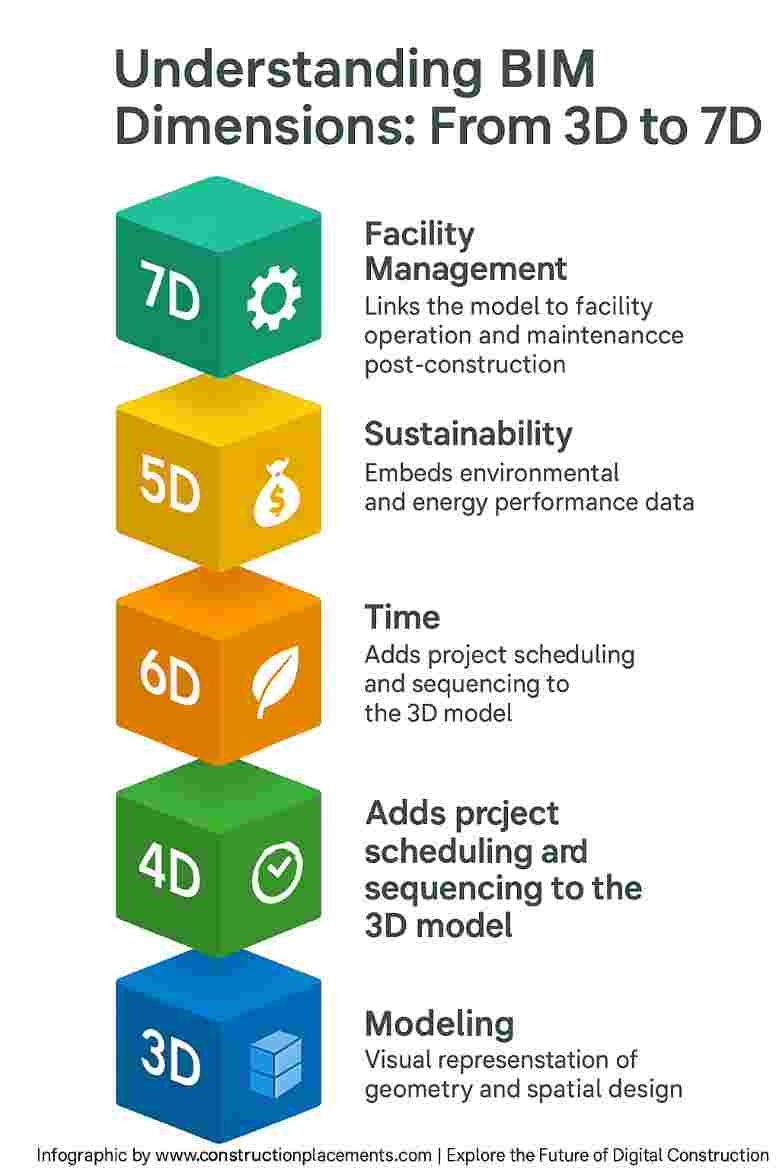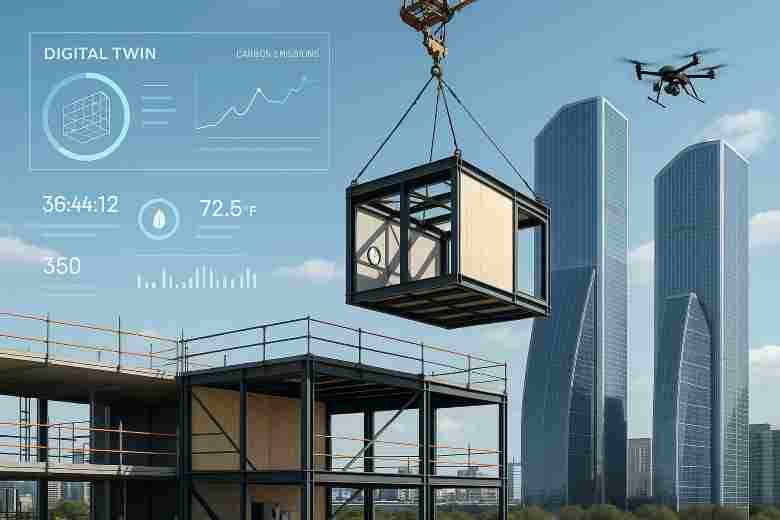Last Updated on April 27, 2025 by Admin
The global construction industry is barreling into a pivotal year. After a decade of incremental digital adoption, 2025 is set to deliver an inflection point where climate urgency, labor shortages, and exponential tech innovation finally converge. Construction Trends 2025 are no longer buzzwords for early adopters; they’re strategic imperatives that determine who wins bids, attracts talent, and secures finance.
From net-zero building codes sweeping major markets to investor pressure for transparent carbon data, stakeholders across the value chain—contractors, owners, engineers, EPC firms, even insurers—are under intense scrutiny. Meanwhile, generative AI, digital twins, and 6D BIM are slashing rework and unlocking predictive decision-making unheard-of just five years ago. This article unpacks the ten most disruptive Construction Trends 2025, explaining what they are, why they matter, and how forward-thinking firms are already cashing in.
Table of Contents
#1. Green Building Technologies & Net-Zero Construction
What It Is
A holistic suite of design, material, and operational strategies—PV façades, heat-pump HVAC, embodied-carbon tracking—aimed at delivering buildings that produce as much energy as they consume.
Practice 15+ AI-generated technical and HR interview questions for Civil, BIM, QS, Planning, HSE and Construction roles. Get instant feedback, improved answers, a 7-day improvement plan, and a full PDF report. Designed exclusively for construction professionals.
One free full interview session included. No credit card required.
Why It Matters
- 70 % of global CO₂ comes from cities; buildings contribute 37 %. Nations from the EU to India are tightening performance codes toward net-zero by 2030.
- Green premiums translate into 4–7 % higher lease rates and lower financing costs.
Examples
- Sovereign Tower, Singapore—first Asia-Pacific high-rise to achieve net-positive energy via hybrid PV and AI-optimized shading.
- Microsoft Redmond Campus refresh expects 50 % embodied-carbon cuts through low-carbon concrete mixes.
Future Outlook
Expect green-building certifications to become table stakes. Explore: Green Building Techniques.

#2. Modular & Prefabricated Construction Advances
What It Is
Off-site manufacturing of volumetric modules or panels that are assembled rapidly on-site.
Why It Matters
The modular market will jump from US $103.9 billion in 2025 to US $131.2 billion by 2030 (CAGR 4.8 %), driven by schedule certainty and cleaner sites.
Examples
- CitizenM’s hotel pipeline: 80 % factory-built rooms, 40 % faster handover.
- India’s GatiShakti housing uses steel pods to deliver 1,024 flats in 14 months.
Future Outlook
Expect AI-configured module catalogs and robotics-assisted factories, lowering unit costs enough to disrupt traditional design-bid-build.
#3. Digital Twins & Smart Construction Sites
What It Is
Real-time, data-rich virtual replicas of assets fed by IoT sensors, drones, and BIM models.
Why It Matters
Public agencies are piloting digital twins for critical infrastructure, using drone and sensor data to foresee maintenance needs.
Examples
- I-35 Bridge (Minnesota): Twin Warns engineers of stress anomalies, saving an estimated US$ $3 million annually in inspection costs.
- ENR survey shows 62 % of top contractors plan to twin all megaprojects by year-end 2025.
Future Outlook
Cloud-native twins will merge with 6D BIM and carbon dashboards, letting owners simulate whole-life emissions before pouring concrete.

#4. AI & Machine Learning Take Over Project Management
What It Is
Algorithms that crunch schedules, risk logs, and cost histories to predict delays, optimize sequences, and automate RFIs.
Why It Matters
The construction-AI market will soar from US$ $3.9 billion in 2024 to US$ $22.7 billion by 2030. Deloitte forecasts 83 % of major cities deploying AI for permitting within three years.
Examples
- Skanska slashed RFI cycle time 30 % with a generative-AI assistant.
- Kajima uses predictive analytics to cut crane downtime by 15 %.
Future Outlook
Agentic AI will autonomously re-sequence tasks overnight, pushing a live update to every subcontractor’s phone by dawn.
#5. Robotics & Drones Redefine On-Site Operations
What It Is
Autonomous or semi-autonomous robots (bricklaying, rebar tying) and UAVs for mapping, progress verification, and safety checks.
Why It Matters
Construction-robot revenues are projected to hit US $4.1 billion by 2032. Drone adoption in construction already commands a US$ $4.8 billion market.
Examples
- Boston Dynamics Spot roams Skanska sites, capturing 360° progress photos.
- Built Robotics’ exosystem allowed Mortenson to trench 20 % faster for a solar farm.
Future Outlook
Expect integrated “robo-fleets” connected to digital twins, auto-updating QC logs in real time.
#6. Advanced BIM: 6D & 7D Adoption
What It Is
Beyond 3D geometry: 4D scheduling, 5D cost, 6D sustainability data, and 7D facilities-management inputs.
Why It Matters
Research shows 6D/7D BIM delivers up to 23 % lifecycle-cost saving through preventive maintenance optimization.
Examples
- Crossrail UK links 6D models to asset tags, cutting annual OPEX by £70 million.
- Qatar’s Education City integrates 7D BIM into CAFM platforms for a 40-building portfolio.
Future Outlook
AI-augmented BIM will auto-flag embodied-carbon hotspots, completing the feedback loop between design intent and as-built performance.

#7. 3D Printing for Large-Scale Builds
What It Is
Layer-by-layer additive manufacturing of structural elements or entire homes.
Why It Matters
3D-printed houses can cut material waste by 60 % and labor by 70 %, while producing walls in 12 hours.
Examples
- ICON + Lennar delivering a 100-home community in Texas.
- Dubai’s municipal target: 25 % of all new builds 3D-printed by 2030.
Future Outlook
Hybrid printers capable of steel and concrete deposition will enable multi-story mid-rise cores by 2027, accelerating Construction Trends 2025 into mainstream.
#8. Next-Gen Materials: Self-Healing Concrete & Carbon-Absorbing Bricks
What It Is
Bio-enzymatic or mineral additives that heal micro-cracks; masonry units that sequester CO₂ during curing.
Why It Matters
The self-healing concrete market will jump to US$ $93.9 billion in 2025 (CAGR 36 %). Carbon-negative bricks such as CO₂-SUICOM are hitting commercial scale.
Examples
- Basilisk microsilica admixture used on Dutch highways reduces maintenance closures by 50 %.
- MCi Carbon’s Australian pilot will open in 2025 to turn captured CO₂ into bricks.
Future Outlook
Expect ESG-minded financiers to demand lifecycle CO₂ data sheets, making these materials default specs.
#9. Workforce Transformation & Upskilling
What It Is
Training initiatives and new roles—BIM Analyst, Drone Pilot, AI Prompt Engineer—addressing the tech-skills gap.
Why It Matters
70% of contractors cite digital talent scarcity as their top growth constraint. McKinsey notes firms with structured upskilling outperform peers’ EBIT by 5 points.
Examples
- Bechtel Digital Academy cross-trains superintendents in Python for data-driven planning.
- India’s National Skill Council launches a Drone Pilot certification aligned with DGCA rules.
Future Outlook
Look for mixed-reality (MR) simulators replacing classroom safety training, and pay premiums for tech-savvy site engineers—see this link Construction AI Careers.
#10. Regulatory Shifts: Sustainability & Safety
What It Is
Governments are tightening carbon-reporting, waste-recycling quotas, and mandating digital site logs.
Why It Matters
• EU Taxonomy requires embodied-carbon disclosures for buildings > 2,000 m² starting 2025.
• India’s new Occupational Safety Code enforces mandatory IoT-based worker tracking on megaprojects.
Examples
- California’s CALGreen 2025 targets a 40 % water-use reduction via plumbing retrofits.
- UK’s Building Safety Act now obliges a “Golden Thread” of digital information for high-rise residential.
Future Outlook
Compliance will favour contractors already invested in digital twins and ESG reporting dashboards—hallmarks of winning Construction Trends 2025 bids.
Final Thoughts
The 2025 playbook for construction success is clear: adopt data-rich processes, embrace planet-positive materials, and cultivate a digitally fluent workforce. These ten Construction Trends 2025 aren’t distant forecasts—they are already altering bid matrices, project timelines, and profit margins worldwide. Companies that proactively invest in modular factories, AI scheduling, 6D BIM expertise, and carbon-negative materials will pull ahead of the pack.
Now is the moment to audit your tech stack, partner with innovators, and upskill teams. The rewards? Faster delivery, fatter margins, and projects that stand as sustainable benchmarks long after ribbon-cutting. The future of the construction industry leadership belongs to those who act, starting today.


